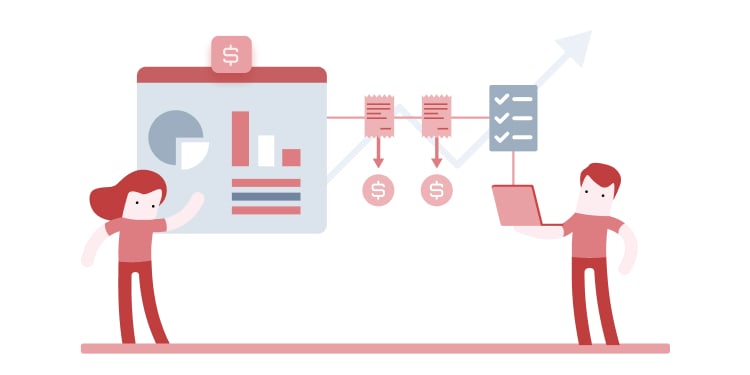ARTICLE SUMMARY
Technology is available in so many different ways that it can be tricky. The key to success is using it efficiently. When managing a marketing campaign, make sure to apply it in essential steps of a campaign, such as creating the strategy, setting approval flows, meeting launch deadlines and measuring results.

Over the past couple of years, digital has gone from being one part of the marketing mix to an integral part of a whole range of marketing processes. Technology allows the best teams to have efficient marketing campaign management.
That’s essential to reach their audience on the platforms that matter to them. Teams are better able to make sound, data-driven decisions and evaluate performance based on tangible, hard-number KPIs, allowing them to consistently exceed expectations.
So how are the best teams running their campaigns? What are the best practices for marketing campaign management, and how can technology help you apply them? Let’s take a look at how you can use today’s software platforms to help you run campaigns that deliver.
Define Your Goals, Audience, and Strategy
First of all, it’s important to have a clear definition of these three essential concepts.
- The Goal: Your goal is why you are running this campaign. It might be to promote a new product, increase brand awareness or generate revenue.
- The Audience: Your audience consists of recipients of the campaign who exist within a predetermined target market.
- The Strategy: Your marketing strategy is the plan you will use to execute your campaign. It answers the question “How will I find and attract buyers?”.
How Software Can Help Define Your Goals, Audience, and Strategy
Organizing your ideas is critical to being able to clearly define your campaign plans. Process Management software can help you keep all your data and information in one place. You won’t have to sift through thousands of emails, navigate spreadsheets and click-through presentations just to get the information you need.
Process management software integrates with the different platforms you use to aggregate all that data in a single dashboard. This won’t just save you time and effort: With all the information right there, you can easily set up main goals, define the target audience and form the strategies you need to execute your campaign effectively.
Stick to Your Budget

For many creative people, the word budget has unfortunate connotations—much like the words diet or straightjacket. In fact, a budget is just a plan that provides safeguards to keep you from running out of cash during a marketing campaign. The best budgets include both a month-by-month schedule and a red-light decision point, letting you know when you should take action if a line item isn’t earning the ROI it should.
How Software Can Help You Stick to Your Budget
Specialized budgeting software for marketing teams exists to help you plan and measure your campaign performance. Project your campaign’s expenses, adhere to those expenses and see results in real-time so you can adjust the budget throughout the campaign.
Powerful budget and project scoping templates put key data points right in front of you. Whether it’s tracking campaign ROI, expensing, invoicing or managing project scope, templates present the right data in clear, actionable formats.
Integrate All Teams and Keep Stakeholders Updated
Keeping clients and team members informed and involved helps keep your campaign running smoothly. Being upfront, informative and approachable helps, but being collaborative is the key here. When a client or another team member in the workflow process can check on what’s going on at any time, you can eliminate surprises and awkward conversations.
How Software Can Help You Integrate All Teams and Keep Stakeholders Updated
A collaborative work platform such as Pipefy lets you integrate all your operations and view them at a glance. You no longer have to look through stacks of spreadsheets to find the information you need because it’s all there, right at your fingertips.
You’re likely communicating with clients, team members and other stakeholders across a range of different platforms. This can make it difficult to ensure that everyone knows what’s going on, since mail trails, conversations and decisions aren’t always visible to everyone.
Collaboration software integrates multiple communication channels and formats. By integrating all your conversations on a single platform, you can ensure that everyone’s on the same page, all the time. This lets you create a seamless handoff between marketing and sales by standardizing your process flow so no client or campaign gets stuck in the process.
Set a Schedule for Launching, Monitoring and Evaluating Your Campaign
What goes unscheduled goes undone. A schedule needs to make note of every step in your campaign, from conception to post-mortem. If your launch date isn’t on the calendar, your launch will likely get missed. And if you don’t schedule regular times to monitor and evaluate your campaign, those pieces of the project will get short shrift—or fall by the wayside completely.
How Software Can Make Sure Your Campaign Stays on Schedule
Marketing management tools that offer customized workflows with clearly assigned tasks can assist you with creating schedules while fostering collaboration. Look for cloud-based software that can be shared with your entire team. These tools allow you to follow up on activities and make sure they get completed on time.
Management tools help you to have clear visibility to ensure that everything stays on track, all the time. For example, creating a standard of execution makes no step being missed, easily track where each demand is and what are the next steps.
That’s why if a series of tasks are always repeating, it’s an indication that they should be standardized to, rather than creating them manually, fully control the campaign flow. Software platforms allow you to schedule, automate and monitor recurring tasks with ease.
Make Sure Briefings and Approvals Are Done Hassle-Free
You definitely want to avoid surprises when communicating with your clients and management. Communication works best when the information you need to discuss is easy to access. Organization and preparation build trust between your team and those granting approval.
How Software Can Help You Make Sure Briefings and Approvals Are Hassle-Free
Not only does workflow management software give you easy-to-find information, but it also provides visibility into your full process from end to end. This feature lets you offer up-to-the-minute information and keep interested parties informed of changes or new ideas in real-time. By the time your briefing or approval meeting rolls around, clients and management should know as much as you do about how and where a project is going.
Management software simplifies the approval process as well as making it more transparent to all stakeholders. Automated approval—for example, on social media campaign spend—can speed up the approval process when approval conditions have been agreed on beforehand.
Meanwhile, dashboarding ensures that clients, decision-makers and your team are all on the same page when it comes to approvals. This saves time and reduces potential friction from approval miscommunication
Test Everything Before You Launch It

Testing your campaign lets you know what works and what doesn’t. Choosing not to test your marketing campaign puts you at enormous risk for blowing the budget or alienating your buyers. While testing may sound cumbersome or expensive, it doesn’t have to be. You can use Twitter to test email subject lines. Put content samples on Facebook and see what results you get. Pop just one video onto YouTube and keep an eye on the thumbs up button and the comment section.
How Software Can Help You Test Everything Before You
Several types of software allow you to different aspects of your campaign to ensure that it’s the very best it can be. There’s no one-size-fits-all approach to campaigns. What works for one organization might not work for you. A/B testing is a great way to objectively test different ideas before choosing which ones to implement.
A/B testing software allows you to share campaign variants with different audience groups to find out what resonates best. Then, workflow software lets you delegate responsibility for testing and reviewing. You can keep track of who’s in charge of testing exercises and use testing insights to deliver the campaigns your audience will want to engage with.
Analyze Your Campaign’s Results and Improve Team Performance
It’s time to analyze the data! While it’s important to keep up with what’s going on during your campaign, it’s equally vital to conduct a post-mortem review on a completed activity. Use what you learn to improve your next campaign—which should already be in the works.
How Software Can Help You Analyze Your Campaign’s Results
The software can help you organize information from campaigns that are no longer live so you can examine their efficiency in one spot. Keeping data organized will become increasingly important as you scale and run more marketing campaigns at once.
Software solutions can give you end-to-end visibility into all previous campaigns. Everything from creating reports, testing results, ROI and customer feedback is available for reference. This helps you understand why some aspects of a campaign may have worked while others didn’t. Templatized solutions are particularly useful: you can port successful campaign elements into future campaigns with minimal hassle.
The Takeaway: Make the Most of Your Software
Conducting a marketing campaign means organizing a lot of creative work, several team members and huge data flow—some marketing executives call that herding cats. The sheer volume of work coupled with the complexity of each piece can make marketing campaign management a huge challenge even for an experienced team.
Campaign management software and work management platforms like Pipefy can alleviate that challenge by helping you manage every step of your campaign from beginning to end.








